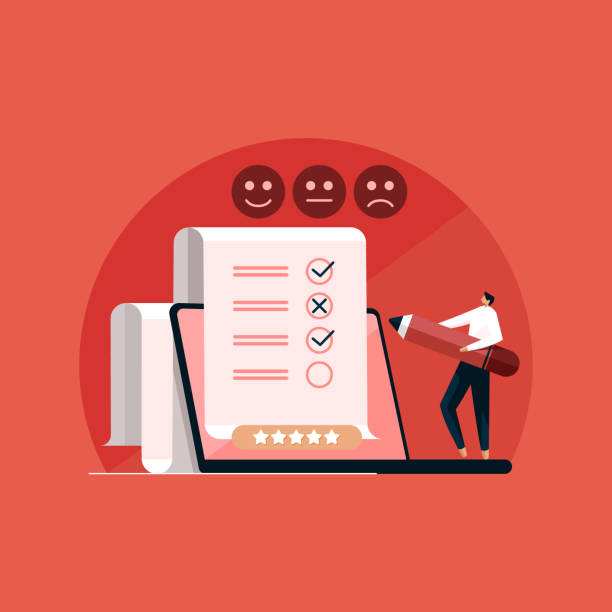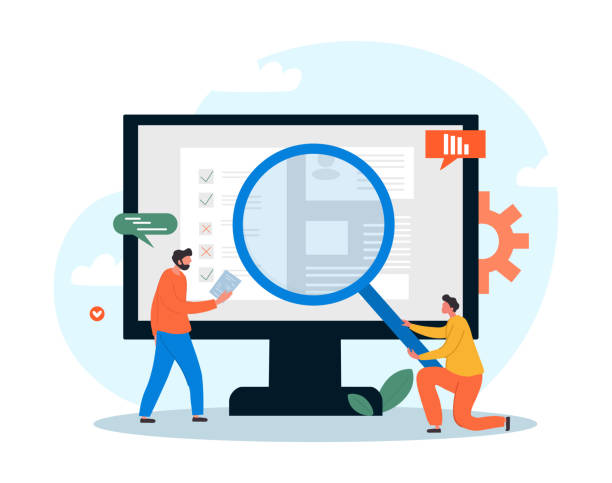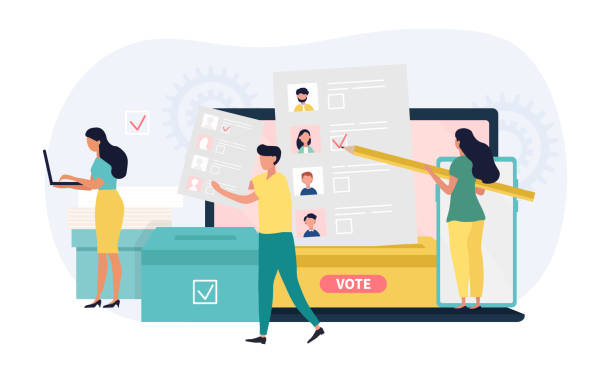Introduction to User-Friendly Website Design and Its Importance

In today’s digital world, having a website is not just about having an online presence; rather, the key to success is user-friendly website design.
This concept goes beyond visual aesthetics and focuses on the overall user experience when interacting with a website.
A user-friendly website is easy to navigate, provides information simply, and offers an enjoyable and hassle-free experience.
#UserFriendlyWebsiteDesign means creating an environment where visitors can achieve their goals without confusion or frustration, whether it’s purchasing a product, finding information, or establishing communication.
The importance of this approach lies in increasing conversion rates, improving SEO rankings, and building customer loyalty.
A website that discourages users not only misses business opportunities but can also harm brand reputation.
Therefore, every website design must be carried out with the needs and behaviors of the end-user in mind.
In this article, we will educationally and explanatorily address various aspects of user-friendly website design so you can create a successful and customer-centric website.
Did you know that 94% of users’ first impressions of a website are related to its design? This statistic clearly shows how vital user-friendly website design is and how a poor design can quickly drive users away from your page.
Tired of losing customers due to poor e-commerce website design? With Rasawwb, solve this problem forever!
✅ Increase sales and conversion rates of visitors into customers
✅ Smooth and engaging user experience for your customers⚡ Get Free Consultation
Key Principles of User Experience (UX) Design

User Experience (UX) is the cornerstone of any user-friendly website design.
This design aspect specifically focuses on users’ emotions, attitudes, and perceptions before, during, and after using a product or system.
Key UX principles include usability, accessibility, value, desirability, and findability.
A website with strong UX helps users quickly achieve their goals, find the information they need, and have a positive experience that encourages them to return.
For example, clear and logical navigation, appropriate visual hierarchy, and immediate feedback to user actions are crucial elements.
Guiding users through a clear path prevents confusion and directs them toward completing desired tasks.
Does your website design truly meet user needs, or does it just look pretty? This is a thought-provoking question that UX designers should constantly ask themselves.
User research, persona creation, user journey mapping, and usability testing are all vital tools in the UX design process.
These steps ensure that the final design is not only beautiful but also efficient and tailored to user expectations.
Proper implementation of these principles helps user-friendly website design to be not only attractive but also highly efficient and contribute to the website’s business goals.
The Role of User Interface (UI) in User-Friendly Design

While User Interface (UI) addresses the visual and interactive aspects of a website, its role in user-friendly website design is undeniable.
Good UI enhances excellent UX.
An attractive and intuitive user interface that correctly organizes elements and allows users to easily interact with the system forms a significant part of a positive user experience.
UI elements include buttons, icons, images, typography, color palettes, and the overall page layout.
Harmony and beauty in these elements not only make the website engaging but also easy to use.
For example, using contrasting colors for Call-to-Action buttons or familiar icons for functions helps users find their way without much thought.
An optimized UI design means creating a consistent visual language that is maintained across all website pages.
This consistency builds user trust and assures them that they are navigating in a familiar environment.
Ignoring UI means overlooking the visual aspects, which are the first things a user encounters and can make the difference between staying and leaving the website.
The table below shows some key differences between UX and UI:
| Feature | User Experience (UX) | User Interface (UI) |
|---|---|---|
| Main Goal | Solve user problems, improve user feelings | Look and feel of interaction, aesthetics |
| Focus on | Research, analysis, information architecture, usability | Graphics, color, typography, layout |
| Design Stages | Wireframing, prototyping, user testing | Visual design, interaction design, animation |
Both of these elements complement each other and are crucial for achieving a user-friendly website design.
Responsiveness and Mobile-First

In the current era, where the majority of users access the internet via mobile devices, Responsive Design and the Mobile-First approach are of paramount importance and are integral to user-friendly website design.
A responsive website automatically adjusts its layout to the screen size of the user’s device, meaning your website will display optimally whether on a large desktop computer, a medium tablet, or a small smartphone.
This feature is crucial for ensuring a seamless and positive user experience across all platforms.
The mobile-first approach goes a step further; in this method, designers first design the mobile version of the website and then gradually expand it for larger screens.
This approach ensures that the most important elements and functionalities work correctly in the mobile version, as screen space is more limited on mobile devices.
From a technical standpoint, Google also gives more importance to mobile-first websites, and this can directly impact your SEO ranking.
Is your website optimized for mobile users? This is a thought-provoking question that must have a positive answer to stay competitive in the digital realm.
The main guidance is to prioritize mobile compatibility for any user-friendly website design.
Did you know that 85% of customers review your company’s website before any interaction?
With Rasawwb, build a corporate website worthy of your reputation.
✅ Increase credibility and customer trust
✅ Attract high-quality leads
⚡ Get Free Website Design Consultation
The Importance of Load Speed and Optimization

Website load speed is one of the most important factors in user-friendly website design and directly impacts user experience and SEO.
Studies have shown that users expect a website to load in less than three seconds, and otherwise, many of them leave the page.
This means losing visitors and potential opportunities.
Speed optimization includes compressing images, using browser caching, reducing the number of HTTP requests, optimizing CSS and JavaScript codes, and using a CDN (Content Delivery Network).
These specialized measures help your website provide faster service to users.
Furthermore, load speed is an important ranking factor for search engines like Google; faster websites appear higher in search results.
This is a crucial analysis for any business that wants to succeed online.
It is recommended to regularly use tools like Google PageSpeed Insights or GTmetrix to evaluate and improve your website’s speed.
Did you know that every 1-second delay in page load can lead to a 7% decrease in conversions? This statistic clearly shows how vital speed optimization is for efficient website design and how a slow website can directly harm your business.
A user-friendly website design never sacrifices speed for beauty.
Impactful and Engaging Content for Users

Content is king, and this phrase also applies to user-friendly website design.
Even if your website is technically and visually perfect, without high-quality, relevant, and engaging content, it will not be able to retain users.
Impactful content should be informative and at the same time engaging.
This content can include text, images, videos, infographics, and podcasts.
The main goal of content is to provide value to users, whether this value is in the form of information, entertainment, or guidance.
Your content should answer users’ questions, solve their problems, and accompany them on their user journey.
Using simple, clear, and understandable language, along with attractive headings and short paragraphs, increases text readability.
Also, including keywords relevant to your business in the content significantly helps improve SEO rankings.
Is your content written in a way that encourages users to share and interact? This is a thought-provoking question you should ask yourself when producing content.
A user-friendly website design not only pays attention to appearance but also to what is said and how it is said.
Engaging content not only attracts users but also converts them into loyal customers.
Therefore, for any user-friendly website design, investing in high-quality and strategic content creation is of paramount importance.
Accessibility and Inclusion in Web Design

Web Accessibility means designing and developing websites in such a way that people with disabilities can easily use them.
This is a critical ethical and legal aspect of user-friendly website design.
Inclusion means ensuring that your website is accessible to everyone, regardless of their abilities, geographical location, or device used.
This includes providing alt text for images for visually impaired users, keyboard navigation for those who cannot use a mouse, providing captions for videos for hearing-impaired users, and using appropriate color contrast for users with low vision.
Ignoring accessibility not only means excluding a large portion of the population from your services but can also lead to legal consequences.
This is an educational and technical topic that every web designer must master.
Is your website usable by everyone? This is a thought-provoking question that should be asked at every stage of user-friendly website design.
By adhering to the WCAG (Web Content Accessibility Guidelines) standards, you can ensure that your website is inclusive and accessible to all.
An inclusive website design is not only ethical but also expands your target market.
| Guideline | Explanation | Practical Example |
|---|---|---|
| Alt Text (Alternative Text) | Text descriptions for images, readable by screen readers | <img src="..." alt="A view of the sunset"> |
| Keyboard Navigation | Ability to access all interactive elements using Tab and Enter | Links and buttons should have a clear focus state. |
| Appropriate Color Contrast | Sufficient contrast between text and background colors | Black text on a white or light gray background. |
| Subtitles and Transcripts | Providing subtitles for videos and transcripts for audio content | Adding SRT files to videos. |
User Behavior Analysis and Continuous Improvement

User behavior analysis is a critical and continuous process for any user-friendly website design.
By using tools like Google Analytics, Hotjar, and Crazy Egg, you can collect valuable data on how users interact with your website.
This data includes users’ navigation paths, visited pages, time spent on each page, click points, bounce rate, and conversion rate.
Analyzing this information helps you identify the strengths and weaknesses of your website design and make informed decisions for its improvement.
For example, if you notice that users abandon the website at a specific stage of the purchasing process, you can review and optimize that section.
This process is called Continuous Improvement and is essential for maintaining user satisfaction and staying ahead of competitors.
Do you regularly analyze your user behavior data? This thought-provoking question is the key to increasing your website’s efficiency.
Collecting direct feedback from users through surveys and usability tests is also a good complement to data analysis.
This data-driven approach ensures that any changes to your website design are based on actual user needs and aim to improve their experience.
Did you know that 94% of the first impression of a company is related to its website design?
Rasawwb helps you create the best first impression by providing professional corporate website design services.
✅ Create a professional and trustworthy image for your brand
✅ Attract potential customers more easily and improve online presence
⚡ Get Free Corporate Website Design Consultation
Common Website Design Mistakes and How to Avoid Them

On the path to achieving a user-friendly website design, designers and developers may make mistakes that disrupt the user experience.
Understanding these mistakes and knowing how to avoid them is very important.
One of the most common mistakes is a cluttered and information-heavy design that confuses users.
A website should have enough white space to make content readable and digestible.
Another mistake is complex and non-intuitive navigation that prevents users from easily finding what they want.
Clear menus, proper labeling, and a logical hierarchy are essential.
The key guidance is to always prioritize simplicity.
Ignoring website load speed is also a major mistake, as mentioned earlier.
Excessive use of large and unoptimized images, or heavy scripts, can severely increase load times.
Lack of responsiveness and lack of optimization for mobile is also a significant error in the current era.
Other mistakes include using inconsistent colors and inappropriate typography, neglecting accessibility, and failing to provide visual feedback to users when interacting with website elements.
Are you making these mistakes in your website design? This is a thought-provoking question that requires honest self-assessment.
Through continuous learning and following best practices, these mistakes can be avoided to achieve a user-friendly website design.
The Future of User-Friendly Website Design and Emerging Trends

The world of user-friendly website design is constantly evolving, and with the emergence of new technologies and changing user expectations, new trends are appearing.
One of these trends is Artificial Intelligence (AI) and Machine Learning (ML), which allow websites to offer more personalized experiences.
Smart chatbots and content recommendations based on user behavior are examples of these applications.
Another is advanced interactive design with subtle animations, micro-interactions, and engaging visual effects that make the user experience more engaging.
News indicates that voice search is also becoming an important trend due to the increased use of voice assistants like Siri and Google Assistant, which requires content optimization to answer voice queries.
Augmented Reality (AR) and Virtual Reality (VR) are also gradually entering web design and have the potential to create fully immersive experiences.
This analysis shows that user-friendly website design is moving towards greater intelligence, personalization, and interaction.
Designers must constantly keep themselves updated with these changes to build websites that are effective and attractive not only today but also in the future.
Frequently Asked Questions
And other services of Rasa Web Advertising Agency in the field of advertising
Smart Social Media: A fast and efficient solution for campaign management focusing on user experience customization.
Smart Marketplace: Designed for businesses seeking user engagement through precise audience targeting.
Smart Direct Marketing: A novel service for improving SEO rankings through Google Ads management.
Smart Website Development: A professional solution for user interaction focusing on SEO-driven content strategy.
Smart Digital Advertising: A combination of creativity and technology to increase sales through an SEO-driven content strategy.
And over a hundred other services in the field of internet advertising, advertising consulting, and organizational solutions
Internet Advertising | Advertising Strategy | Sponsored Articles
References
Key Tips for User-Friendly Website Design
How to Design a User-Friendly Website?
Complete Guide to User Experience Design
The Importance of User Interface in Online Success
? RasaWeb Afarin: Your Success Partner in the Digital World! For the growth and visibility of your business online, trust our expertise. By providing comprehensive digital marketing services, including corporate website design, SEO, social media management, and content creation, we pave the way for you to achieve your goals.
📍 Tehran, Mirdamad Street, next to Bank Markazi, Kazeroun Jonoubi Alley, Ramin Alley, No. 6
